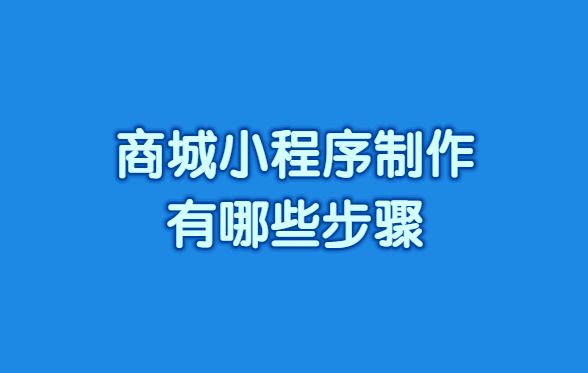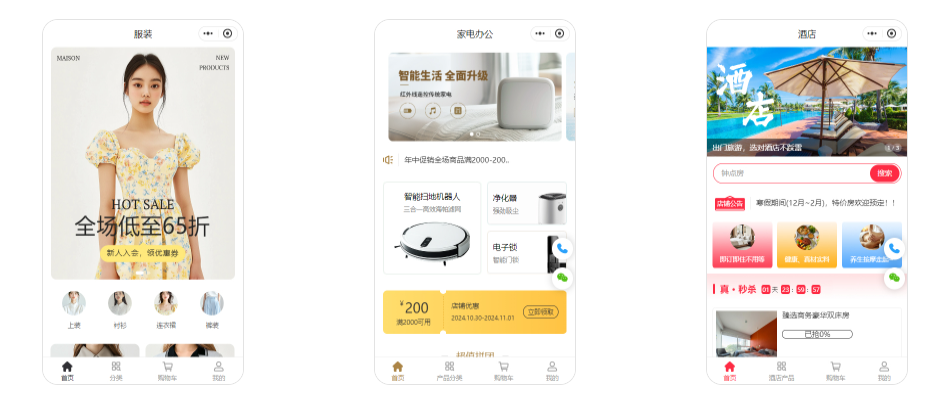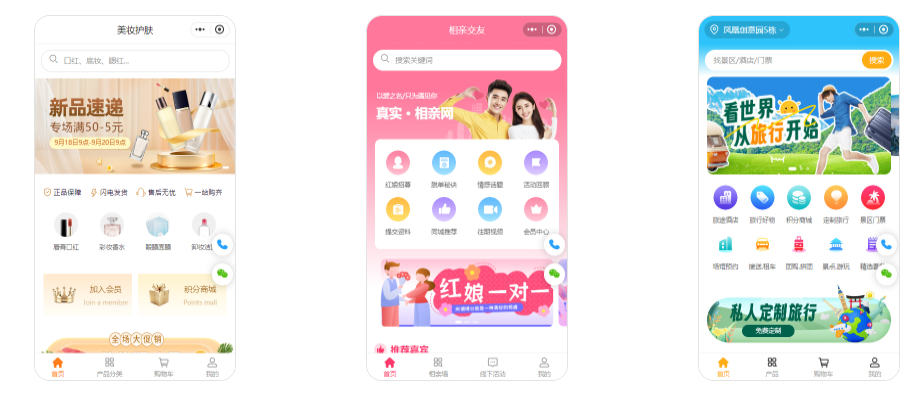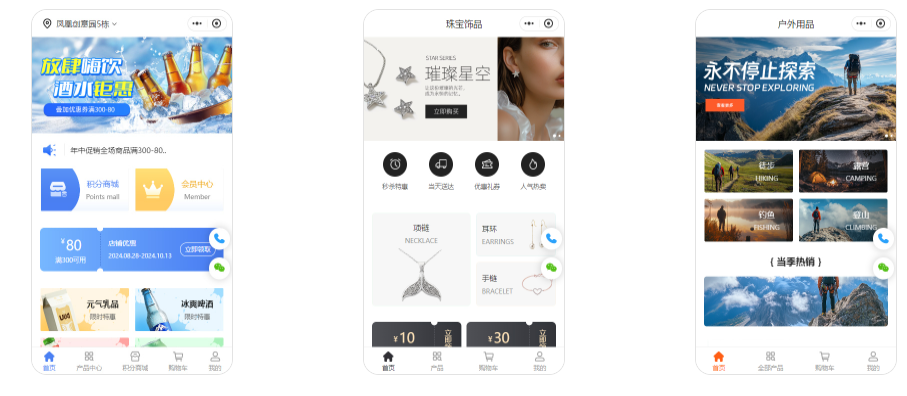如今,很多商家都纷纷选择开设自己的小程序商城,尤其是年轻人,喜欢尝试不需要太多技术背景的工具。那么,作为一名00后小姐姐,如何才能制作一个属于自己的小程序商城呢?本文将详细介绍商城小程序制作的步骤,并分享一些真实案例,帮助大家更好地理解并实现这一目标。即使你不懂代码,也能够通过一些简单的操作完成一个小程序商城的搭建。

一:制作商城小程序的第一步——选择平台
其实,制作商城小程序并没有大家想的那么复杂。首先,你需要选择一个适合的小程序开发平台,这一步很关键。像微信小程序、百度智能小程序、支付宝小程序等,都是市场上主流的平台,每个平台都有自己的特点,选择一个你熟悉的平台会更容易入门。
我个人推荐选择微信小程序,因为微信的用户量大,大家平时用得多,商机也相对丰富。其实对于00后小姐姐来说,微信小程序的开发并不需要太多的专业知识。你只需要选择一个适合的第三方开发工具,就能快速开始制作小程序。像杰建云这些工具,都提供了丰富的模板和组件,操作起来非常简单。
很多小伙伴也分享了他们的经验:“我自己开了个小吃店,之前一直没时间学习编程,后来用微擎做了一个小程序商城,现在每天都有很多订单,真的很方便!”
二:设置小程序商城的基本框架
好,选择了平台后,我们接下来就要搭建商城的小程序框架了。其实这一步你完全不用担心代码问题,平台上的工具都会提供现成的模板。你可以根据自己的需求选择一个合适的商城模板,然后进行相应的修改。
比如说,商城的首页布局、分类模块、商品展示等,都可以通过拖拽或者点击操作来完成。这些模板本身就有预设的功能,像产品展示、购物车、支付接口等,都可以轻松集成进去。
我记得我第一次试着做小程序商城的时候,看到一大堆设置选项,其实有点迷茫。但按照教程一步一步来,发现其实没那么难。只要你对自己的商城有个大致的规划,就可以很快设置好基本框架。

有个网友分享:“我没什么技术背景,按照平台的模板一步一步做,基本上花了不到两天就搞定了,超简单!”下面就分享一个案例:
以下是一个较为简单的商城小程序搭建示例代码,包含了商品展示、加入购物车、商品详情查看以及简单的购物车结算功能,涉及到小程序的多个核心文件,下面为你详细介绍:
1. app.js(小程序入口文件)
收起
javascript
// app.js
App({
onLaunch: function () {
// 小程序启动时的初始化操作,可在此进行一些全局设置,比如获取用户信息授权等,此处暂未详细实现
},
globalData: {
// 用于存放全局数据,例如当前登录用户信息、购物车商品总数等,这里先不做具体赋值
}
})
2. app.json(小程序全局配置文件)
收起
json
{
"pages": [
"pages/index/index",
"pages/productDetail/productDetail",
"pages/cart/cart"
],
"window": {
"backgroundTextStyle": "light",
"navigationBarBackgroundColor": "#000",
"navigationBarTitleText": "商城小程序",
"navigationBarTextStyle": "white"
},
"tabBar": {
"list": [
{
"pagePath": "pages/index/index",
"text": "首页",
"iconPath": "icon/home.png",
"selectedIconPath": "icon/home_selected.png"
},
{
"pagePath": "pages/cart/cart",
"text": "购物车",
"iconPath": "icon/cart.png",
"selectedIconPath": "icon/cart_selected.png"
}
]
}
}
在这个配置文件中:
pages字段定义了小程序包含的页面路径,这里有首页、商品详情页和购物车页面。window字段设置了小程序窗口的一些基本样式,如导航栏的背景色、标题文字颜色等。tabBar字段配置了底部导航栏,指定了两个选项卡(首页和购物车)对应的页面路径、显示文字以及图标路径(需提前准备好对应的图标文件放在icon文件夹下,该文件夹位于项目根目录)。
3. pages/index/index.wxml(首页结构文件)
收起
html
<!-- pages/index/index.wxml -->
<view class="container">
<view class="product-list">
<block wx:for="{{productList}}" wx:key="id">
<view class="product-item" bindtap="goToProductDetail" data-id="{{item.id}}">
<image class="product-image" src="{{item.imageUrl}}" mode="aspectFill"></image>
<view class="product-info">
<text class="product-name">{{item.name}}</text>
<text class="product-price">¥{{item.price}}</text>
</view>
</view>
</block>
</view>
</view>
此页面结构展示了商品列表,通过 wx:for 指令循环遍历 productList(在对应的 index.js 文件中定义数据)来展示每个商品。每个商品项包含商品图片、名称和价格,并且绑定了点击事件 goToProductDetail,点击可跳转到商品详情页,同时传递商品的 id 参数。
4. pages/index/index.wxss(首页样式文件)
css
/* pages/index/index.wxss */
.container {
display: flex;
flex-direction: column;
align-items: center;
padding: 20rpx;
}
.product-list {
width: 100%;
display: flex;
flex-wrap: wrap;
justify-content: space-around;
}
.product-item {
width: 45%;
display: flex;
flex-direction: column;
align-items: center;
margin-bottom: 20rpx;
border: 1rpx solid #ccc;
border-radius: 5rpx;
padding: 10rpx;
}
.product-image {
width: 100%;
height: 200rpx;
border-radius: 5rpx;
margin-bottom: 10rpx;
}
.product-info {
text-align: center;
}
.product-name {
font-size: 20rpx;
margin-bottom: 5rpx;
}
.product-price {
font-size: 18rpx;
color: #f00;
}
这里主要对首页的整体布局、商品列表以及每个商品项的样式进行设置,使商品展示更清晰美观,页面布局更合理。
5. pages/index/index.js(首页逻辑文件)
javascript
// pages/index/index.js
Page({
data: {
productList: [
{
id: 1,
name: "智能手机",
price: 3999,
imageUrl: "https://example.com/smartphone.jpg"
},
{
id: 2,
name: "蓝牙耳机",
price: 299,
imageUrl: "https://example.com/earphone.jpg"
},
{
name: "运动手环",
price: 199,
imageUrl: "https://example.com/fitness_bracelet.jpg",
id: 3
}
]
},
goToProductDetail: function (e) {
const productId = e.currentTarget.dataset.id;
wx.navigateTo({
url: `/pages/productDetail/productDetail?id=${productId}`
});
}
})
在首页逻辑文件中,data 里初始化了一个商品列表 productList,包含商品的基本信息(id、name、price、imageUrl)。goToProductDetail 函数用于处理商品项的点击事件,获取点击商品的 id 后,通过 wx.navigateTo 方法跳转到商品详情页,并将商品 id 作为参数传递过去。
6. pages/productDetail/productDetail.wxml(商品详情页结构文件)
html
<!-- pages/productDetail/productDetail.wxml -->
<view class="detail-container">
<image class="detail-image" src="{{product.imageUrl}}" mode="aspectFill"></image>
<view class="detail-info">
<text class="detail-name">{{product.name}}</text>
<text class="detail-price">¥{{product.price}}</text>
<text class="detail-description">{{product.description}}</text>
<button bindtap="addToCart">加入购物车</button>
</view>
</view>
该文件构建了商品详情页的结构,展示商品的图片、名称、价格、详细描述,并提供了 “加入购物车” 按钮,点击可触发添加购物车的操作。这里通过双大括号绑定 product 对象中的属性来显示具体信息,product 对象的数据会在对应的 js 文件中获取和设置。
7. pages/productDetail/productDetail.wxss(商品详情页样式文件)
css
/* pages/productDetail/productDetail.wxss */
.detail-container {
display: flex;
flex-direction: column;
align-items: center;
padding: 20rpx;
}
.detail-image {
width: 100%;
height: 300rpx;
border-radius: 5rpx;
margin-bottom: 10rpx;
}
.detail-info {
text-align: center;
width: 100%;
}
.detail-name {
font-size: 22rpx;
font-weight: bold;
margin-bottom: 5rpx;
}
.detail-price {
font-size: 20rpx;
color: #f00;
margin-bottom: 10rpx;
}
.detail-description {
font-size: 16rpx;
margin-bottom: 20rpx;
}
button {
padding: 10rpx 20rpx;
background-color: #007aff;
color: white;
border-radius: 5rpx;
}
此样式文件对商品详情页的各元素样式进行了设置,让商品详情展示更有条理且美观,突出重点信息,按钮样式也更符合常规的操作界面风格。
8. pages/productDetail/productDetail.js(商品详情页逻辑文件)
javascript
// pages/productDetail/productDetail.js
Page({
data: {
product: {}
},
onLoad: function (options) {
const productId = options.id;
const allProducts = getApp().globalData.productList || [];
const product = allProducts.find(item => item.id === productId);
this.setData({
product: product
});
},
addToCart: function () {
const product = this.data.product;
const cart = getApp().globalData.cart || [];
const existingProduct = cart.find(item => item.id === product.id);
if (existingProduct) {
existingProduct.quantity++;
} else {
const newProduct = {...product, quantity: 1 };
cart.push(newProduct);
}
getApp().globalData.cart = cart;
wx.showToast({
title: '已加入购物车',
icon: 'success'
});
}
})
在商品详情页逻辑文件中:
data里先初始化一个空的product对象,用于后续存放当前展示商品的详细信息。onLoad生命周期函数在页面加载时被调用,通过获取传递过来的商品id参数,从全局的商品列表(这里假设可以通过getApp().globalData.productList获取,实际应用中可能需要从服务器获取更准确的数据)中查找对应的商品,并将其数据设置到product对象中,用于页面展示。addToCart函数处理 “加入购物车” 按钮的点击事件,先获取当前商品信息,然后判断购物车中是否已存在该商品,如果存在则数量加1,如果不存在则将商品以数量为1的形式添加到购物车数组中,最后更新全局的购物车数据,并弹出提示框告知用户已加入购物车。
9. pages/cart/cart.wxml(购物车页面结构文件)
html
<!-- pages/cart/cart.wxml -->
<view class="cart-container">
<view class="cart-item" wx:for="{{cart}}" wx:key="id">
<text class="cart-item-name">{{item.name}}</text>
<text class="cart-item-price">¥{{item.price}}</text>
<text class="cart-item-quantity">数量: {{item.quantity}}</text>
<button bindtap="minusQuantity" data-id="{{item.id}}"> - </button>
<button bindtap="plusQuantity" data-id="{{item.id}}"> + </button>
<button bindtap="removeFromCart" data-id="{{item.id}}">移除</button>
</view>
<view class="total-price">
<text>总价: ¥{{totalPrice}}</text>
</view>
<button bindtap="placeOrder">去结算</button>
</view>
购物车页面结构展示了购物车中的商品列表,每个商品项包含名称、价格、数量以及增减数量和移除商品的按钮。同时,页面底部显示了购物车商品的总价,并提供了 “去结算” 按钮。
10. pages/cart/cart.wxss(购物车页面样式文件)
css
/* pages/cart/cart.wxss */
.cart-container {
display: flex;
flex-direction: column;
align-items: center;
padding: 20rpx;
}
.cart-item {
display: flex;
justify-content: space-between;
align-items: center;
width: 100%;
border-bottom: 1rpx solid #ccc;
padding: 10rpx 0;
}
.cart-item-name {
font-size: 20rpx;
}
.cart-item-price {
font-size: 18rpx;
color: #f00;
}
.cart-item-quantity {
font-size: 18rpx;
}
button {
padding: 5rpx 10rpx;
background-color: #007aff;
color: white;
border-radius: 5rpx;
}
.total-price {
font-size: 22rpx;
font-weight: bold;
margin-top: 20rpx;
}
这里设置了购物车页面的整体样式,包括商品项的布局样式、文字样式以及按钮样式等,让购物车页面看起来清晰整洁,方便用户操作。
11. pages/cart/cart.js(购物车页面逻辑文件)
javascript
// pages/cart/cart.js
Page({
data: {
cart: [],
totalPrice: 0
},
onShow: function () {
const cart = getApp().globalData.cart || [];
const totalPrice = cart.reduce((acc, item) => acc + item.price * item.quantity, 0);
this.setData({
cart: cart,
totalPrice: totalPrice
});
},
minusQuantity: function (e) {
const productId = e.currentTarget.dataset.id;
const cart = this.data.cart;
const product = cart.find(item => item.id === productId);
if (product.quantity > 1) {
product.quantity--;
}
this.updateCartAndTotalPrice();
},
plusQuantity: function (e) {
const productId = e.currentTarget.dataset.id;
const cart = this.data.cart;
const product = cart.find(item => item.id === productId);
product.quantity++;
this.updateCartAndTotalPrice();
},
removeFromCart: function (e) {
const productId = e.currentTarget.dataset.id;
const cart = this.data.cart.filter(item => item.id!== productId);
this.setData({
cart: cart
});
this.updateCartAndTotalPrice();
},
updateCartAndTotalPrice: function () {
const cart = this.data.cart;
const totalPrice = cart.reduce((acc, item) => acc + item.price * item.quantity, 0);
getApp().globalData.cart = cart;
this.setData({
cart: cart,
totalPrice: totalPrice
});
},
placeOrder: function () {
// 这里可以添加真正的下单逻辑,比如将购物车数据发送到服务器等
wx.showToast({
title: '下单成功',
icon: 'success'
});
getApp().globalData.cart = [];
this.setData({
cart: [],
totalPrice: 0
});
}
})
在购物车页面逻辑文件中:
data里初始化了购物车商品列表cart和总价totalPrice。onShow生命周期函数在页面每次显示时被调用,用于从全局获取购物车数据,重新计算总价,并更新页面数据显示。minusQuantity、plusQuantity、removeFromCart这几个函数分别处理购物车中商品数量减少、增加以及移除商品的操作,操作完成后都会调用updateCartAndTotalPrice函数来更新购物车数据和总价,并同步更新全局的购物车数据。placeOrder函数处理 “去结算” 按钮的点击事件,这里暂时只是简单弹出下单成功提示框,并清空购物车数据(实际应用中需与服务器交互进行真正的下单流程)。
这就是一个简单商城小程序搭建的完整代码示例啦,不过这只是基础功能实现,在实际开发中,你可以根据需求进一步完善功能,比如添加商品分类筛选、用户登录注册、地址管理以及对接支付接口等更复杂的功能哦。希望这个示例对你有所帮助呀!
三:添加商品信息,丰富商城内容
有了基础框架之后,我们接下来的任务就是丰富商城的内容,尤其是商品信息。这个环节可以说是最考验耐心的,但其实也并不难。你只需要按平台提供的商品管理模块,把你的商品信息输入进去,就可以展示在商城里了。
商品信息包括商品名称、价格、库存、描述等内容,有些平台还支持图片和视频的上传,让你的商品展示更有吸引力。要是你担心没有好的产品拍摄技巧,可以先用手机拍几张清晰的图片,尽量避免用过于模糊或过度美化的照片。
一位网友提到:“一开始我还觉得商品上传是个麻烦事,后来我发现只要拍几张清晰的图上传,系统自动就会生成产品详情页,省了不少事。”
四:支付功能的设置与测试
当商城的内容基本完成后,我们就进入了支付功能的设置环节。很多平台提供了集成支付接口的功能,像微信支付、支付宝支付等,商家只需要在后台进行相关设置,链接好支付账号,就能完成支付功能的对接。
其实,支付功能的设置并不复杂,但是一定要记得测试一下是否能顺利支付。特别是你打算上线后,很多顾客会通过扫码支付购买商品,确保支付流程顺畅是非常重要的。

我自己在做测试时,也曾遇到过支付不成功的情况,后来才发现是支付接口没有正确配置。建议大家在正式发布前,多测试几次,确保商城能够正常运营。
有网友曾分享:“设置支付功能时,我也曾遇到支付接口无法链接的问题。幸好平台客服很快就帮我解决了,支付成功后,整个流程就很顺畅。”
五:商城上线前的优化与推广
商城制作完成后,你需要对其进行一定的优化和推广,才能吸引更多顾客。这个阶段,你可以通过平台提供的优化工具,比如SEO设置、活动促销、会员管理等,提升商城的曝光率和转化率。
其实,商城的推广并不一定需要花费很多钱。你可以通过朋友圈、微信群、公众号等渠道进行推广,让你的朋友和潜在客户知道你的商城。像微信小程序,它本身就具有一定的社交属性,顾客可以轻松分享商城链接,吸引更多人加入。
网友反馈:有网友分享道:“我的商城上线后,做了一些小活动,结果吸引了很多老顾客回购,也收获了不少新客户。”
说实话,刚开始做小程序商城的时候,我也是一头雾水的。尤其是完全不懂代码的情况下,担心自己做不好,最后做出来的效果会很差。但后来我发现,制作一个商城小程序真的没有想象中那么复杂。只要选择对的平台,利用好现成的模板和功能,完全可以在短时间内搭建起一个适合自己的商城。

当然,商城制作只是第一步,后续的运营和推广同样重要。通过优化、推广等手段,才能让你的商城真正发挥出作用。
总的来说,商城小程序制作不需要太多编程技术,平台的工具和模板非常适合像我一样的00后小姐姐。通过一些简单的操作,我们就可以拥有属于自己的小程序商城,走上创业的第一步。希望这篇文章能给大家一些启发,也许你就能像我一样,尝试做出一个属于自己的小程序商城哦!
有个网友总结道:“其实做商城小程序的门槛不高,关键在于后续的经营和运营。我做了一段时间,已经有了固定的客户群,生意也慢慢稳定下来,真心觉得挺值得做的。”
























 被折叠的 条评论
为什么被折叠?
被折叠的 条评论
为什么被折叠?








